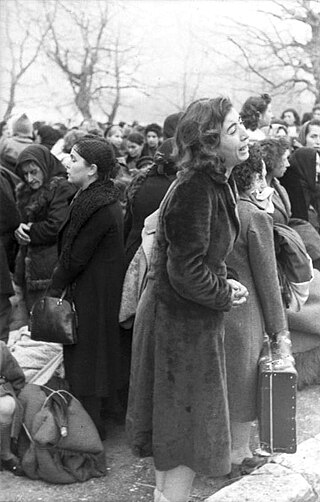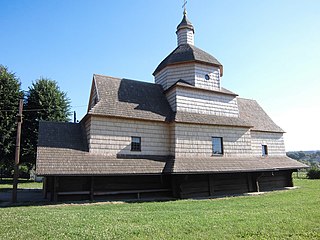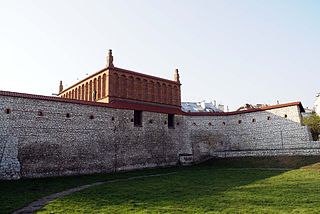
Przemyśl is a city in southeastern Poland with 58,721 inhabitants, as of December 2021. In 1999, it became part of the Subcarpathian Voivodeship; it was previously the capital of Przemyśl Voivodeship.

Ternopil Oblast is an oblast (province) of Ukraine. Its administrative center is Ternopil, through which flows the Seret, a tributary of the Dniester. Population: 1,021,713.

Bar is a town located on the Riv River in the Vinnytsia Oblast (province) of central Ukraine. It is the administrative center of the Bar Raion (district), and is part of the historic region of Podolia. The town's estimated population is 15,337

Buchach is a city located on the Strypa River in Chortkiv Raion of Ternopil Oblast (province) of Western Ukraine. It hosts the administration of Buchach urban hromada, one of the hromadas of Ukraine. Buchach rests 135 kilometres south-east of Lviv, in the historic region of Halychyna (Galicia). The city was located in the Polish–Lithuanian Commonwealth until the partitions, followed by the Habsburg monarchy (1772—1804), Austrian empire (1804—1867), Austro-Hungary (1867—1918), West Ukrainian People's Republic (1918—1919), and Poland (1919—1939). The population was estimated at 12,171 .
Żydokomuna is an anti-communist and antisemitic canard, or a pejorative stereotype, suggesting that most Jews collaborated with the Soviet Union in importing communism into Poland, or that there was an exclusively Jewish conspiracy to do so. A Polish language term for "Jewish Bolshevism", or more literally "Jewish communism", Żydokomuna is related to the "Jewish world conspiracy" myth.

Galician Jews or Galitzianers are members of the subgroup of Ashkenazi Jews originating in the levant having developed in the diaspora of the Kingdom of Galicia and Lodomeria, from contemporary western Ukraine and from south-eastern Poland. Galicia proper, which was inhabited by Ruthenians, Poles and Jews, became a royal province within Austria-Hungary after the Partitions of Poland in the late 18th century. Galician Jews primarily spoke Yiddish.

Husiatyn is an urban-type settlement in Chortkiv Raion, Ternopil Oblast (province) in western Ukraine. Alternate spellings include Gusyatin, Husyatin, and Hsiatyn. It hosts the administration of Husiatyn settlement hromada, one of the hromadas of Ukraine. Husiatyn is located on the west bank of the Zbruch River, which once formed the old boundary between Austria-Hungary and the Russian Empire in the 19th century, and the boundary between the Republic of Poland and the Soviet Union during the 1920s and 1930s. The population is 7,032 .

During World War II, the German Wehrmacht committed systematic war crimes, including massacres, mass rape, looting, the exploitation of forced labor, the murder of three million Soviet prisoners of war, and participated in the extermination of Jews. While the Nazi Party's own SS forces was the organization most responsible for the genocidal killing of the Holocaust, the regular armed forces of the Wehrmacht committed many war crimes of their own, particularly on the Eastern Front in the war against the Soviet Union. According to a study by Alex J. Kay and David Stahel, the majority of the Wehrmacht soldiers deployed to the Soviet Union participated in war crimes.

Kopychyntsi is a small city in Chortkiv Raion, Ternopil Oblast, Ukraine. It hosts the administration of Kopychyntsi urban hromada, one of the hromadas of Ukraine. Kopychyntsi is the birthplace of Vasyl Ivanchuk, a chess grandmaster; Israel Jacob Kligler, who led the effort of eradicating malaria in Mandatory Palestine; and Pinhas Lavon, an Israeli politician. Population: 6,502.

Bolekhiv is a regional city in Kalush Raion, Ivano-Frankivsk Oblast (province) of Ukraine. It was once home to a large Jewish community, very few of whom survived World War II. Bolekhiv hosts the administration of Bolekhiv urban hromada, one of the hromadas of Ukraine. Population: 10,259 .

Józef Rufin Wybicki was a Polish nobleman, jurist, poet, political and military activist of Kashubian descent. He is best remembered as the author of "Mazurek Dąbrowskiego", which was adopted as the Polish national anthem in 1927.

The Golden Rose Synagogue, known also as the Nachmanowicz Synagogue, or the Turei Zahav Synagogue was a synagogue in Lviv, western Ukraine. The Golden Rose Synagogue was the oldest synagogue in what is now Ukraine.

Omer Bartov is an Israeli-born historian. He is the Samuel Pisar Professor of Holocaust and Genocide Studies at Brown University, where he has taught since 2000. Bartov is a noted historian of the Holocaust and is considered one of the world's leading authorities on the subject of genocide. The Forward calls him "one of the foremost scholars of Jewish life in Galicia."

Wooden synagogues are an original style of vernacular synagogue architecture that emerged in the former Polish–Lithuanian Commonwealth. The style developed between the mid-16th and mid-17th centuries, a period of peace and prosperity for the Polish-Lithuanian Jewish community. While many were destroyed during the First and Second World Wars, there are some that survive today in Lithuania.

A fortress synagogue is a synagogue built to withstand attack while protecting the lives of people sheltering within it.

Sataniv is an urban-type settlement in Khmelnytskyi Raion, Khmelnytskyi Oblast, Ukraine. It hosts the administration of Sataniv settlement hromada, one of the hromadas of Ukraine. Population: 2,341

John-Paul Himka is an American-Canadian historian and retired professor of history of the University of Alberta in Edmonton. Himka received his BA in Byzantine-Slavonic Studies and Ph.D. in History from the University of Michigan in 1971 and 1977 respectively. The title of his Ph.D. dissertation was Polish and Ukrainian Socialism: Austria, 1867–1890. As a historian Himka was a Marxist in the 1970s–80s, but became influenced by postmodernism in the 1990s. In 2012 he defined his methodology in history as "eclectic".

During the Holocaust, the Jewish population of over 3000 in Bolekhiv in 1940, with additional thousands of Jews brought in from the surrounding villages and towns in 1941 and 1942, was mostly annihilated, brutally, by the Germans with local Ukrainian collaborators. Only 48 of Bolekhiv's Jews were known to have survived the war.
Abstinence was a tactic of draft evasion was a type of hunger strike, employed by young men in the Russian Empire's Jewish Pale of Settlement to be found unfit for military service by the Imperial authorities.

The Great Synagogue of Brody, also known as the Old Fortress Synagogue, was the main synagogue of the Jewish community in Brody. Constructed in the mid-18th century, the building was significantly damaged by the Nazis in 1943, and has since fallen into disrepair.


















